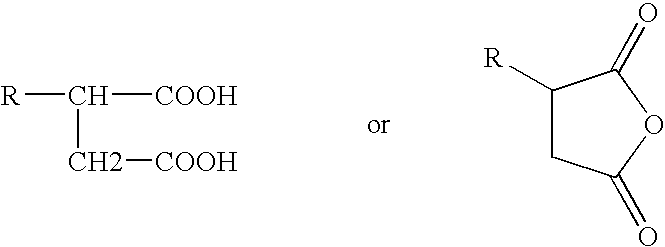Low color polyisobutylene succinic anhydride-derived emulsifiers
a technology of polyisobutylene succinic anhydride and emulsifier, which is applied in the direction of hair cosmetics, drug compositions, transportation and packaging, etc., to achieve the effect of high gardner color readings
- Summary
- Abstract
- Description
- Claims
- Application Information
AI Technical Summary
Benefits of technology
Problems solved by technology
Method used
Image
Examples
example 1
Procedure for Preparation of Low Color Succinic Anhydride Functionalized Polyisobutylene (PIBSA)
[0037] 1. Charge the Glissopal™ 1000 (1900.00 g) and maleic anhydride (167.70 g) to a 3 L wide-necked flange flask.
[0038] 2. The flange flask was closed with a flange lid and clipped. The vessel was equipped with a PTFE stirrer gland, stirrer rod, and overhead mechanical stirrer, nitrogen inlet valve (nitrogen released below the reactant surface gives slightly lower color than released above said surface), thermocouple with eurotherm heating system for 3 L isomantle, and an air condenser capped with a single surface Liebig condenser.
[0039] 3. The sealed reaction vessel was purged with nitrogen.
[0040] 4. The reaction mixture was heated, with stirring at 400 rpm, to 210° C. (maleic anhydride may escape as a gas above 180° C.).
[0041] 5. Once 210° C. was reached, the reaction was held for 3 hours.
[0042] 6. The temperature was then dropped to 200° C., and the reaction set-up was changed ...
example 2
Procedure for Preparing a Low Color Succinic Anhydride Functionalized Polyisobutylene (PiBSA) Under Pressure
[0052] An alternative procedure for making low color PiBSA's under pressure is described.
[0053] 1) A Parr reactor is charged with maleic anhydride (35 g) and Glissopal™ 1000 (360 g).
[0054] 2) The reactor is sealed and connected to the stirrer.
[0055] 3) A nitrogen line is attached to the sub-surface sparge tube and, after ensuring the outlet valve is open, a steady nitrogen purge is applied for 15 min.
[0056] 4) After 15 min, the reactor is sealed and pressurized to 15-20 psig.
[0057] 5) The reactor is heated to 60° C., and the stirrer started.
[0058] 6) The temperature of the reactor is raised to 205° C.
[0059] 7) Once at 205° C., the reaction was held at this temperature for 3 hours.
[0060] 8) After 3 hours, the reactor was cooled to 80° C. The pressure was released and the reactor disassembled.
[0061] 9) The contents of the reactor were poured into a 500 ml flange flask ...
example 3
Making a Surface Active Compound. PIBSA / triethanolamine (TEA)
[0070] A 5000-mL flask was charged with 100 g (0.125 equivalents) of PIBSA prepared as in example 1 and 72.9 g oil. The flask was equipped with a stirrer, thermowell, and above-surface N2 inlet. The system was flushed with N2 gas at 0.1 scfh, heated to 58° C. and 9.34 g (0.063 moles) triethanolamine was added over 1 minute at 58-62° C. The mixture was heated to 75° C. and held at 75° C. for 2 hours to give a product with analyses of % N=0.51, acid number=21.4, and base number=18.9. The intended product is a PIB succinic ester / salt.
PUM
| Property | Measurement | Unit |
|---|---|---|
| Temperature | aaaaa | aaaaa |
| Electric charge | aaaaa | aaaaa |
| Time | aaaaa | aaaaa |
Abstract
Description
Claims
Application Information
 Login to View More
Login to View More - R&D
- Intellectual Property
- Life Sciences
- Materials
- Tech Scout
- Unparalleled Data Quality
- Higher Quality Content
- 60% Fewer Hallucinations
Browse by: Latest US Patents, China's latest patents, Technical Efficacy Thesaurus, Application Domain, Technology Topic, Popular Technical Reports.
© 2025 PatSnap. All rights reserved.Legal|Privacy policy|Modern Slavery Act Transparency Statement|Sitemap|About US| Contact US: help@patsnap.com



